You are herecontent / Migrant Crisis & Syria War Fueled By Competing Gas Pipelines
Migrant Crisis & Syria War Fueled By Competing Gas Pipelines
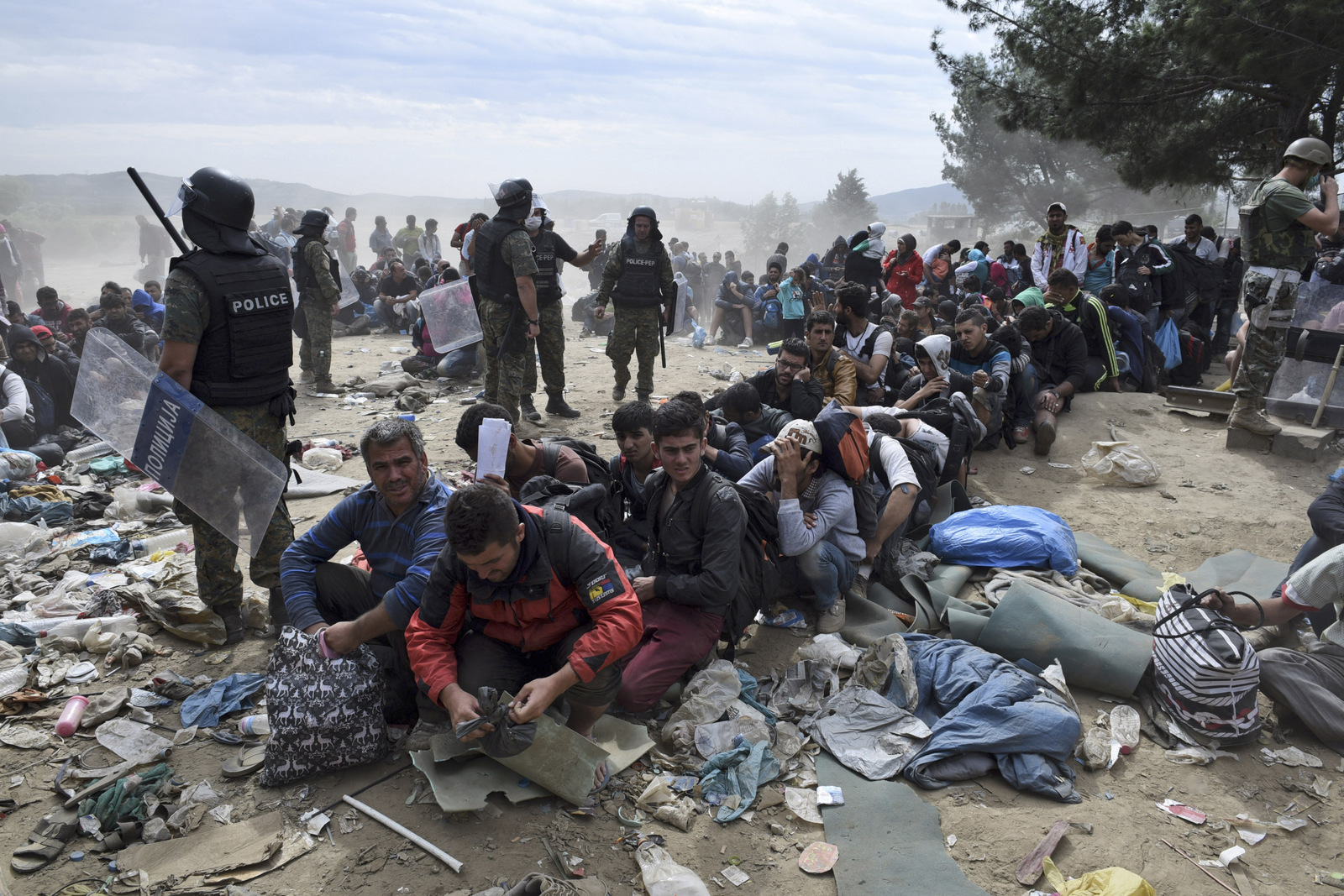
Refugees and migrants wait to cross the border from the northern Greek
village of Idomeni to southern Macedonia, Monday,
Sept. 7, 2015. Greece has borne the brunt of a massive refugee and migration
flow of people heading into the European Union.
(AP Photo/Giannis Papanikos)
MINNEAPOLIS — Images of Aylan Kurdi, the three-year-old Syrian boy who washed up dead on Mediterranean shores in his family’s attempt to flee war-torn Syria, have grabbed the attention of people around the world, sparking outrage about the true costs of war.
The heart-wrenching refugee crisis unfolding across the Middle East and at European borders has ignited a much needed conversation on the ongoing strife and instability that’s driving people from their homes in countries like Syria, Libya and Iraq. It’s brought international attention to the inhumane treatment these refugees are receiving if — and it is a major “if” — they arrive at Europe’s door.
In Syria, for example, foreign powers have sunk the nation into a nightmare combination of civil war, foreign invasion and terrorism. Syrians are in the impossible position of having to choose between living in a warzone, being targeted by groups like ISIS and the Syrian government’s brutal crackdown, or faring dangerous waters with minimal safety equipment only to be denied food, water and safety by European governments if they reach shore.
Other Syrians fleeing the chaos at home have turned to neighboring Arab Muslim countries. Jordan alone has absorbed over half a million Syrian refugees; Lebanon has accepted nearly 1.5 million; and Iraq and Egypt have taken in several hundred thousand.
Although it’s not an Arab nation or even part of the Middle East, Iran sent 150 tons of humanitarian goods, including 3,000 tents and 10,000 blankets, to the Red Crescents of Jordan, Iraq and Lebanon via land routes to be distributed among the Syrian refugees residing in the three countries last year.
Turkey has taken in nearly 2 million refugees to date. Turkey’s Prime Minister Recep Erdogan made international headlines for opening his nation’s arms to migrants, positioning himself as a kind of savior in the process.
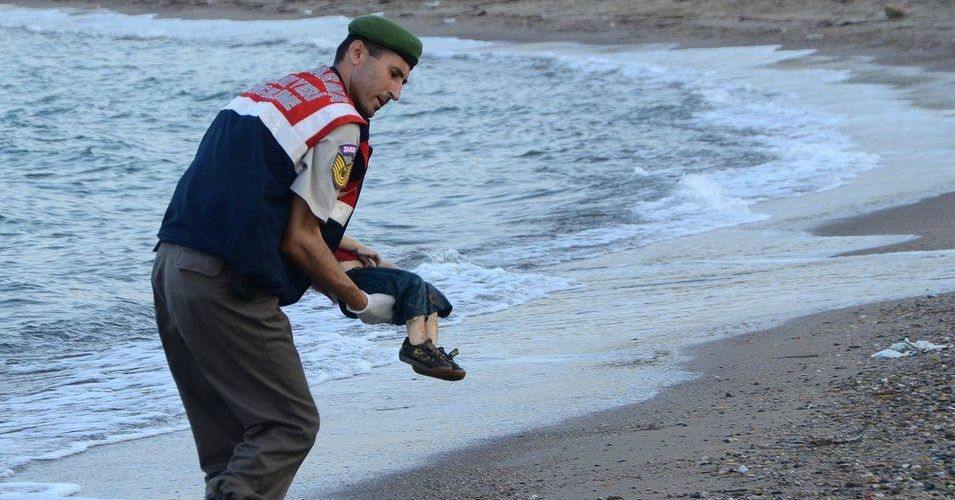
A paramilitary police officer carries the lifeless body of three-year-old Aylan Kurdi after he drowned when the boat he and his family members were in capsized near the Turkish resort of Bodrum early Wednesday, Sept. 2, 2015. (Photo: Nilüfer Demir/DHA)
Meanwhile, Gulf Arab nations like Saudi Arabia, Qatar, Kuwait and the United Arab Emirates have provided refuge to zero Syrian refugees.
While there’s certainly a conversation taking place about refugees — who they are, where they’re going, who’s helping them, and who isn’t — what’s absent is a discussion on how to prevent these wars from starting in the first place. Media outlets and political talking heads have found many opportunities to point fingers in the blame game, but not one media organization has accurately broken down what’s driving the chaos: control over gas, oil and resources.
Indeed, it’s worth asking: How did demonstrations held by “hundreds” of protesters demanding economic change in Syria four years ago devolve into a deadly sectarian civil war, fanning the flames of extremism haunting the world today and creating the world’s second largest refugee crisis?
While the media points its finger to Syrian President Bashar Assad’s barrel bombs and political analysts call for more airstrikes against ISIS and harsher sanctions against Syria, we’re four years into the crisis and most people have no idea how this war even got started.
This “civil war” is not about religion
Citing a lack of access on the ground, the United Nations stopped regularly updating its numbers of casualties in the Syrian civil war in January 2014. Estimates put the death toll between 140,200 and 330,380, with as many as 6 million Syrians displaced, according to the U.N.
While there is no question that the Syrian government is responsible for many of the casualties resulting from its brutal crackdown, this is not just a Syrian problem.
Foreign meddling in Syria began from the onset of the revolt in March 2011. But even according to major media outlets like the BBC and the Associated Press, the demonstrations that supposedly swept Syria were comprised of only hundreds of people.
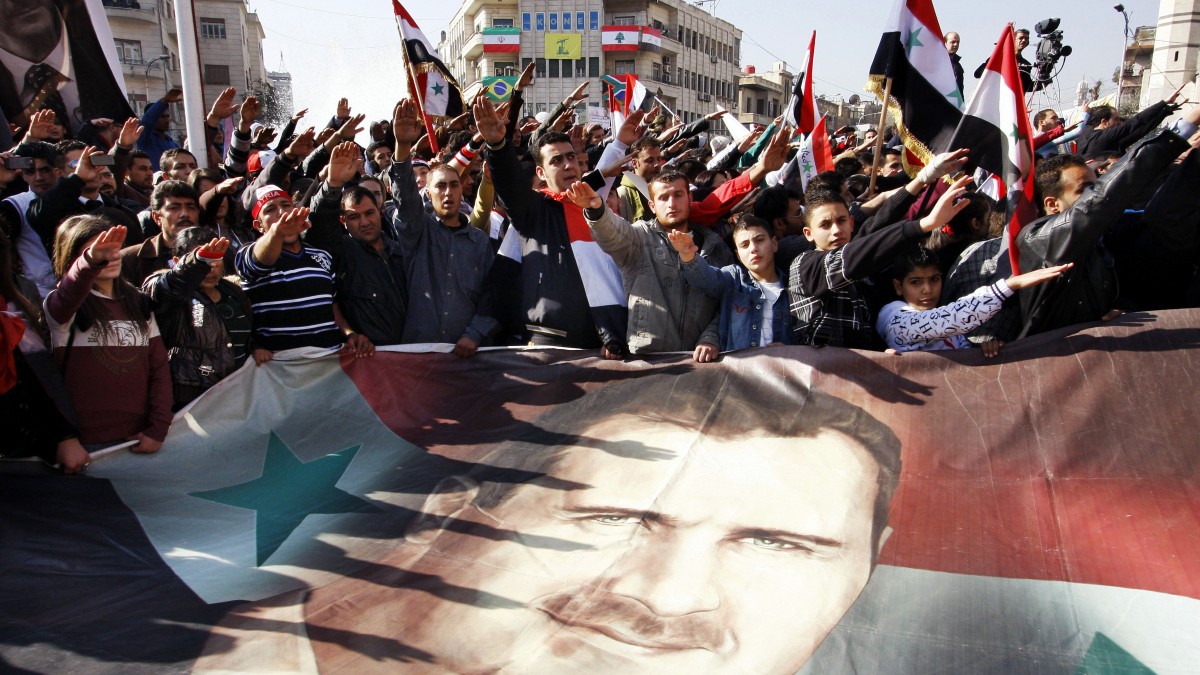
FILE – In this Monday, Dec. 19, 2011 file photo, Syrians hold a large poster depicting Syria’s President Bashar Assad during a rally in Damascus, Syria. Some activists expressed regret that one year later their “revolution” against President Bashar Assad’s rule had become mired in violence. (AP Photo/Muzaffar Salman, File)
While these demonstrations were mostly genuine and represented a real call for economic change, just one month into these demonstrations in April 2011, WikiLeaks released U.S. intelligence revealing a heavy CIA hand in organizing, financing and even arming this revolt.
Just a few months later, with demonstrations growing, rebel groups swarming Syria, and a severe government crackdown sweeping through the country, it became evident that the United States, United Kingdom, France, Qatar, Saudi Arabia and Turkey would be jumping on the opportunity to organize, arm and finance rebels to form the Free Syrian Army. (Just a few months ago, WikiLeaks confirmed this when it released Saudi intelligence that revealed Turkey, Qatar and Saudi Arabia had been working hand in hand to arm and finance rebels to overthrow the Syrian government since 2012.)
These foreign nations created a pact in 2012 called “The Group of Friends of the Syrian People,” a name that couldn’t be further from the truth. Their agenda was to divide and conquer in order to wreak havoc across Syria in view of overthrowing Syrian President Bashar Assad.
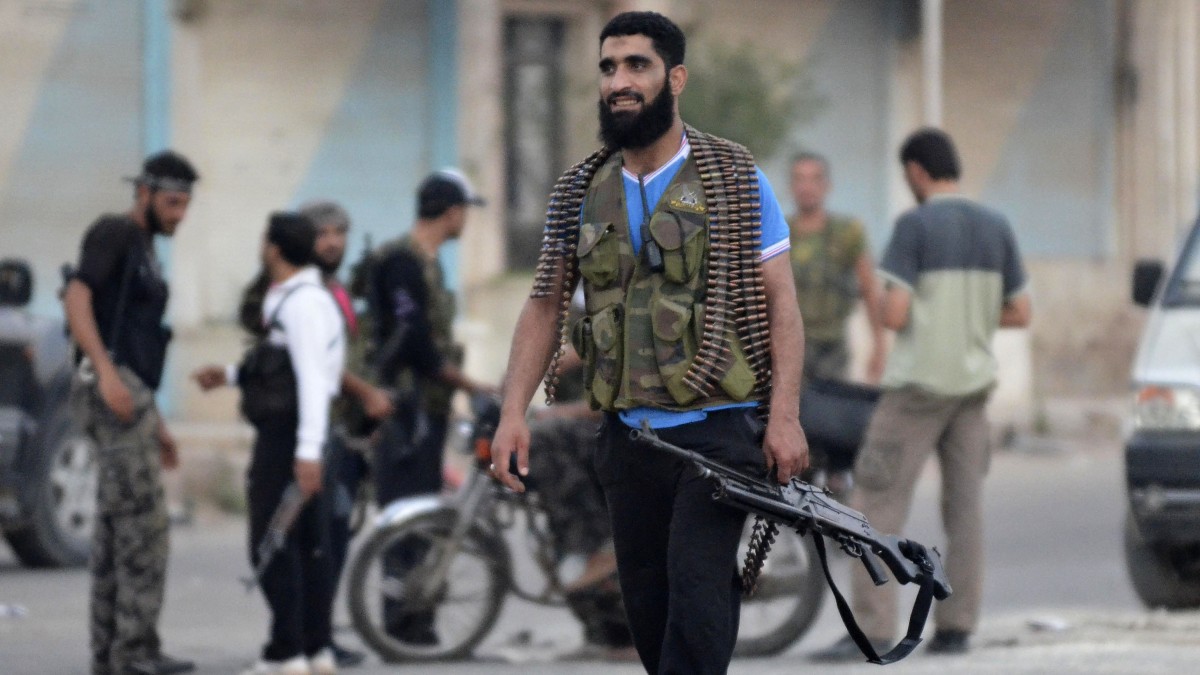
A Free Syrian Army soldier carries his weapon at the northern town of Sarmada, in Idlib province, Syria, Wednesday, Aug. 1, 2012. (AP Photo)
The true agenda to hijack Syria’s revolt quickly became evident, with talking heads inserting Syria’s alliance with Iran as a threat to the security and interests of the United States and its allies in the region. It’s no secret that Syria’s government is a major arms, oil and gas, and weapons ally of Iran and Lebanon’s resistance political group Hezbollah.
But it’s important to note the timing: This coalition and meddling in Syria came about immediately on the heels of discussions of an Iran-Iraq-Syria gas pipeline that was to be built between 2014 and 2016 from Iran’s giant South Pars field through Iraq and Syria. With a possible extension to Lebanon, it would eventually reach Europe, the target export market.
Perhaps the most accurate description of the current crisis over gas, oil and pipelines that is raging in Syria has been described by Dmitry Minin, writing for the Strategic Cultural Foundation in May 2013:
“A battle is raging over whether pipelines will go toward Europe from east to west, from Iran and Iraq to the Mediterranean coast of Syria, or take a more northbound route from Qatar and Saudi Arabia via Syria and Turkey. Having realized that the stalled Nabucco pipeline, and indeed the entire Southern Corridor, are backed up only by Azerbaijan’s reserves and can never equal Russian supplies to Europe or thwart the construction of the South Stream, the West is in a hurry to replace them with resources from the Persian Gulf. Syria ends up being a key link in this chain, and it leans in favor of Iran and Russia; thus it was decided in the Western capitals that its regime needs to change.
It’s the oil, gas and pipelines, stupid!
Indeed, tensions were building between Russia, the U.S. and the European Union amid concerns that the European gas market would be held hostage to Russian gas giant Gazprom. The proposed Iran-Iraq-Syria gas pipeline would be essential to diversifying Europe’s energy supplies away from Russia.
Turkey is Gazprom’s second-largest customer. The entire Turkish energy security structure relies on gas from Russia and Iran. Plus, Turkey was harboring Ottoman-like ambitions of becoming a strategic crossroads for the export of Russian, Caspian-Central Asian, Iraqi and Iranian oil and even gas to Europe.
The Guardian reported in August 2013:
“Assad refused to sign a proposed agreement with Qatar and Turkey that would run a pipeline from the latter’s North field, contiguous with Iran’s South Pars field, through Saudi Arabia, Jordan, Syria and on to Turkey, with a view to supply European markets – albeit crucially bypassing Russia. Assad’s rationale was ‘to protect the interests of [his] Russian ally, which is Europe’s top supplier of natural gas.’”
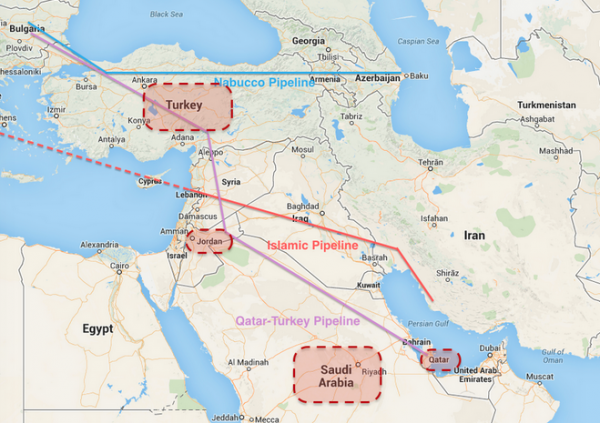
Note the purple line which traces the proposed Qatar-Turkey natural gas pipeline and note that all of the countries highlighted in red are part of a new coalition hastily put together after Turkey finally (in exchange for NATO’s acquiescence on Erdogan’s politically-motivated war with the PKK) agreed to allow the US to fly combat missions against ISIS targets from Incirlik. Now note which country along the purple line is not highlighted in red. That’s because Bashar al-Assad didn’t support the pipeline and now we’re seeing what happens when you’re a Mid-East strongman and you decide not to support something the US and Saudi Arabia want to get done. (Map: ZeroHedge.com)
Knowing Syria was a critical piece in its energy strategy, Turkey attempted to persuade Syrian President Bashar Assad to reform this Iranian pipeline and to work with the proposed Qatar-Turkey pipeline, which would ultimately satisfy Turkey and the Gulf Arab nations’ quest for dominance over gas supplies. But after Assad refused Turkey’s proposal, Turkey and its allies became the major architects of Syria’s “civil war.”
Much of the strategy currently at play was described back in a 2008 U.S. Army-funded RAND report, “Unfolding the Future of the Long War”:
“The geographic area of proven oil reserves coincides with the power base of much of the Salafi-jihadist network. This creates a linkage between oil supplies and the long war that is not easily broken or simply characterized. … For the foreseeable future, world oil production growth and total output will be dominated by Persian Gulf resources. … The region will therefore remain a strategic priority, and this priority will interact strongly with that of prosecuting the long war.”
In this context, the report identifies the divide and conquer strategy while exploiting the Sunni-Shiite divide to protect Gulf oil and gas supplies while maintaining a Gulf Arab state dominance over oil markets.
“Divide and Rule focuses on exploiting fault lines between the various Salafi-jihadist groups to turn them against each other and dissipate their energy on internal conflicts. This strategy relies heavily on covert action, information operations (IO), unconventional warfare, and support to indigenous security forces. … the United States and its local allies could use the nationalist jihadists to launch proxy IO campaigns to discredit the transnational jihadists in the eyes of the local populace. … U.S. leaders could also choose to capitalize on the ‘Sustained Shia-Sunni Conflict’ trajectory by taking the side of the conservative Sunni regimes against Shiite empowerment movements in the Muslim world…. possibly supporting authoritative Sunni governments against a continuingly hostile Iran.”
The report notes that another option would be “to take sides in the conflict, possibly supporting authoritative Sunni governments against a continuingly hostile Iran.”
This framework crafted an interesting axis: Turkey, Qatar, Saudi Arabia, U.S., Britain and France vs. Syria, Iran and Russia.
Divide and conquer: A path to regime change
With the U.S., France, Britain, Qatar, Saudi Arabia and Turkey — aka, the new “Friends of Syria” coalition — publicly calling for the overthrow of Syrian President Bashar Assad between 2011 and 2012 after Assad’s refusal to sign onto the gas pipeline, the funds and arms flowing into Syria to feed the so-called “moderate” rebels were pushing Syria into a humanitarian crisis. Rebel groups were being organized left and right, many of which featured foreign fighters and many of which had allied with al-Qaida.
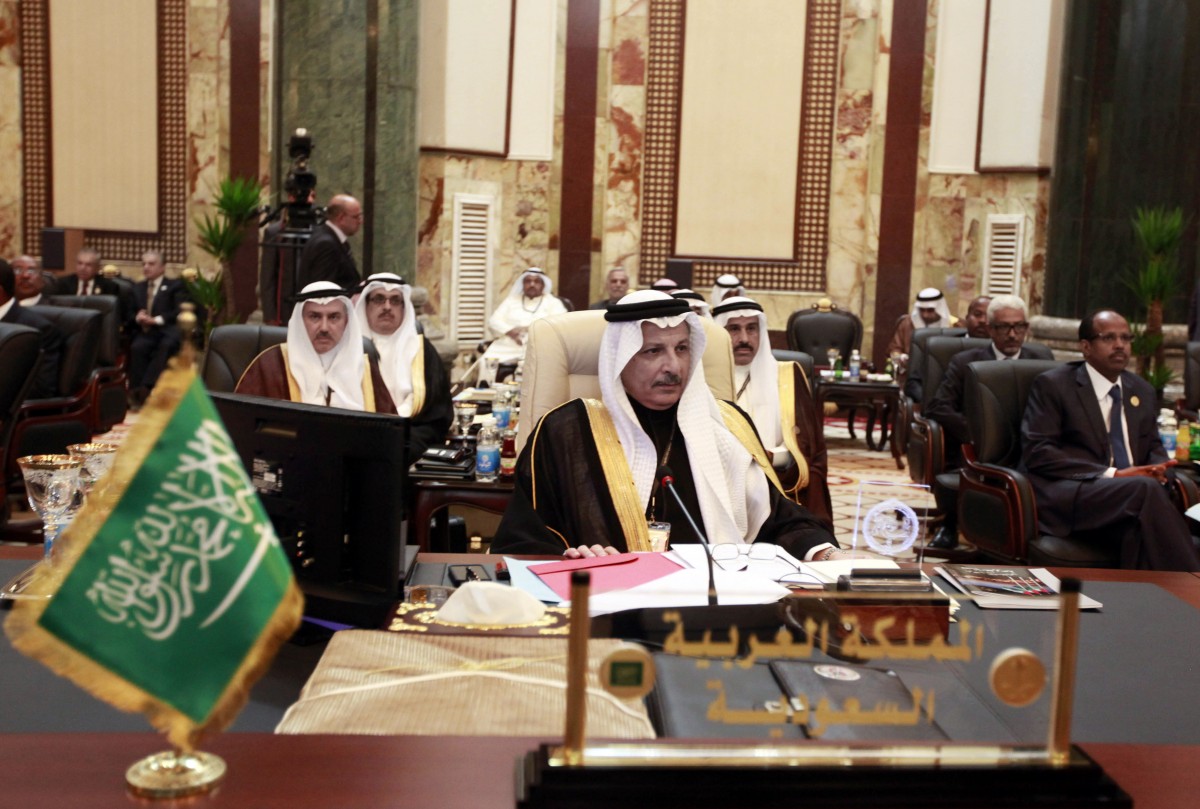
Saudi Arabia’s permanent representative to the League of Arab States Ahmad al-Qattan, center, attends the Arab League summit in Baghdad, Iraq, Thursday, March, 29, 2012. (AP Photo)
The Syrian government responded with a heavy hand, targeting rebel held areas and killing civilians in the process.
Since Syria is religiously diverse, the so-called “Friends of Syria” pushed sectarianism as their official “divide and conquer” strategy to oust Assad. Claiming that Alawites ruled over a majority Sunni nation, the call by the “moderate” U.S.-backed rebels became one about Sunni liberation.
Although the war is being sold to the public as a Sunni-Shiite conflict, so-called Sunni groups like ISIS, the Syrian al-Qaida affiliate Jabhat al-Nusra (the Nusra Front) and even the “moderate” Free Syrian Army have indiscriminately targeted Syria’s Sunnis, Shiites, Christians and Jews. At the same time, these same foreign nations supported and even armed the Bahraini government, which claims to be Sunni, in its violent crackdown on the majority Shiite pro-democracy demonstrations that swept the nation.
The Syrian government army itself is over 80 percent Sunni, which indicates that the true agenda has been politically — not religiously — motivated.
In addition to this, the Assad family is Alawite, an Islamic sect that the media has clumped in with Shiites, though most Shiites would agree that the two are unrelated. Further, the Assad family is described as secular and running a secular nation. Counting Alawites as Shiites was simply another way to push a sectarian framework for the conflict: It allowed for the premise that the Syria-Iran alliance was based on religion, when, in fact, it was an economic relationship.
This framework carefully crafted the Syrian conflict as a Sunni revolution to liberate itself from Shiite influence that Iran was supposedly spreading to Iraq, Syria and Lebanon.
But the truth is, Syria’s Sunni community is divided, and many defected to join groups like the Free Syrian Army, ISIS and al-Qaida. And as mentioned earlier, over 80 percent of Assad’s military is Sunni.
As early as 2012, additional rebels armed and financed by Arab Gulf nations and Turkey like al-Qaida and the Muslim Brotherhood, declared all-out war against Shiites. They even threatened to attack Lebanon’s Hezbollah and Iraq’s government after they had overthrown the Assad government.
Soon after, the majority of the Muslim Brotherhood rebels became part of al-Qaida-affiliated groups. Together, they announced that they would destroy all shrines — not just those ones which hold particular importance to Shiites.
Hezbollah entered the scene in 2012 and allied itself with the Syrian government to fight al-Nusra and ISIS, which were officially being armed and financed by Qatar, Saudi Arabia and Turkey. And all the arms were actively being sold to these nations by the United States. Thus, US arms were falling into the hands of the same terror group the US claims to be fighting in its broader War on Terror.
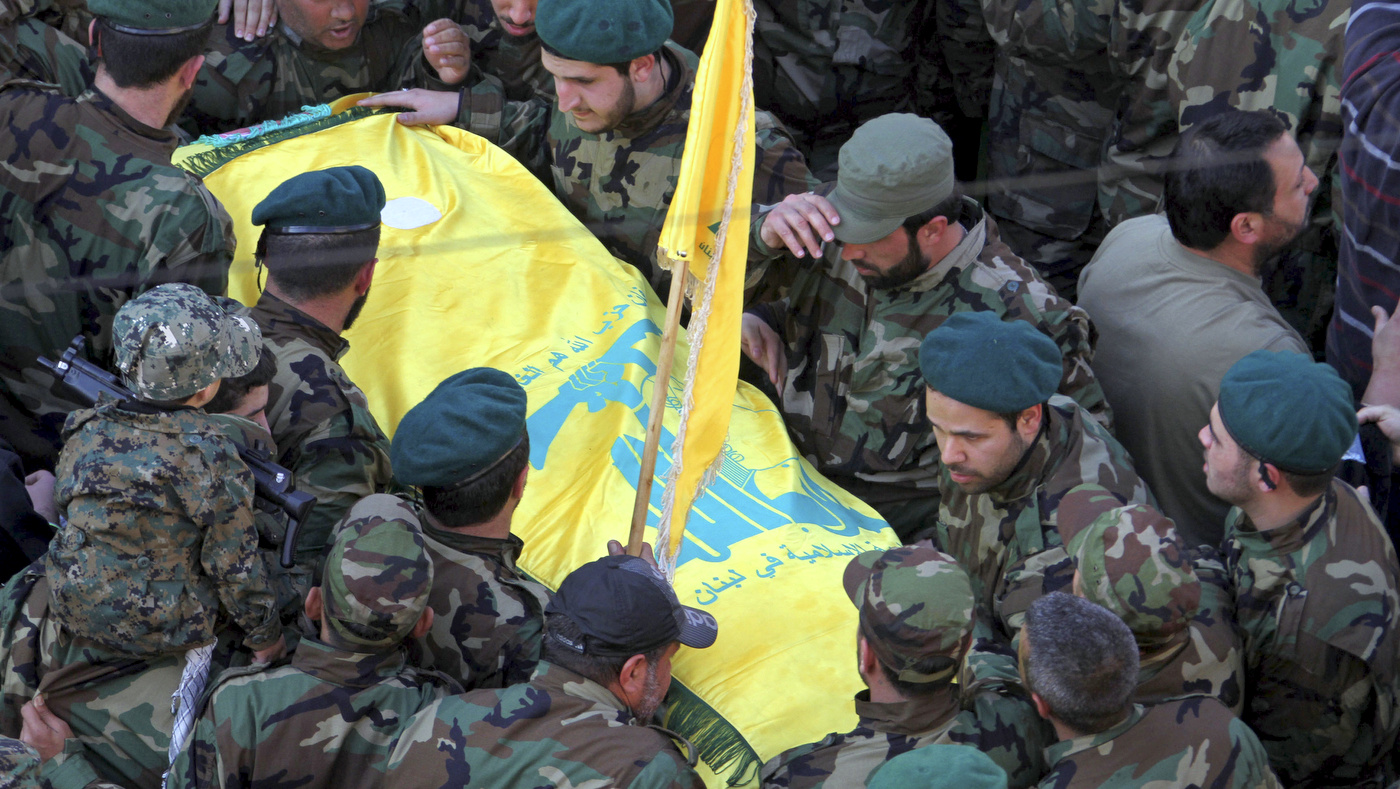
Hezbollah fighters carry the coffin of Hezbollah member Mohammad Issa who was killed in an airstrike that killed six members of the Lebanese militant group and an Iranian general in Syria, during his funeral procession, in the southern village of Arab Salim, Lebanon, Tuesday, Jan. 20, 2015. Hezbollah has accused Israel of carrying out Sunday’s airstrike, which occurred on the Syrian side of the Golan Heights. Issa was the highest-ranking among the group, and was among the senior cadres who headed the group’s operations in Syria against the Sunni-led rebellion. (AP Photo/Mohammed Zaatari)
According to reports, Hezbollah was and has been been active in preventing rebel penetration from Syria to Lebanon, being one of the most active forces in the Syrian civil war spillover in Lebanon. Despite this, the U.S. sanctioned both the Syrian government and Hezbollah in 2012.
Also that year, Russia and Iran sent military advisers to assist the Syrian government in quelling the terror groups, but Iranian troops were not on the ground fighting during this time.
What was once a secular, diverse and peaceful nation, was looking more like it was on its way to becoming the next Afghanistan; its people living under Taliban-style rule as jihadists took over more land and conquered more cities.
Effects of foreign meddling outweigh self-determination
If you think that was hard to follow, you’re certainly not alone.
Most sectarian civil wars are purposely crafted to pit sides against one another to allow for a “divide and conquer” approach that breaks larger concentrations of power into smaller factions that have more difficulty linking up. It’s a colonial doctrine that the British Empire famously used, and what we see taking place in Syria is no different.
So, let’s get one thing straight: This is not about religion. It might be convenient to say that Arabs or Muslims kill each other, and it’s easy to frame these conflicts as sectarian to paint the region and its people as barbaric. But this Orientalist, overly simplistic view of conflict in the Middle East dehumanizes the victims of these wars to justify direct and indirect military action.
If the truth was presented to the public from the perspective that these wars are about economic interests, most people would not support any covert funding and arming of rebels or direct intervention. In fact, the majority of the public would protest against war. But when something is presented to the public as a matter of good versus evil, we are naturally inclined to side with the “good” and justify war to fight off the supposed “evil.”
The political rhetoric has been carefully crafted to make lies sound truthful and murder respectable. Ultimately, no matter the agendas, the alliances or instability brought on by foreign meddling, the calls for freedom, democracy and equality that erupted in 2011 were real then and they’re real today. And let’s not forget that the lack of freedom, democracy and equality have been brought on more by foreign meddling to prop up brutal dictators and arm terror groups than by self-determination.
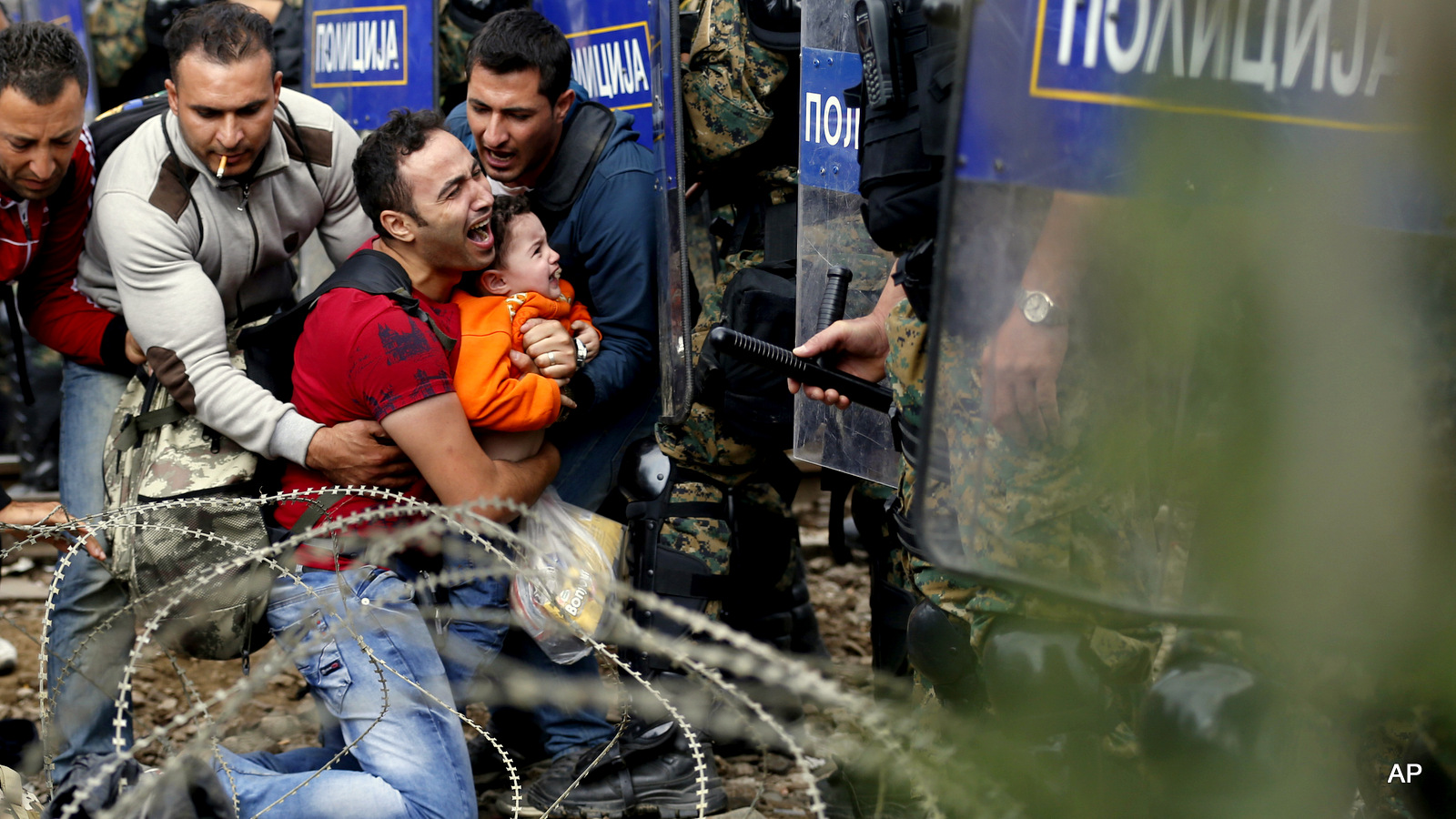
Refugee’s assist a fellow Refugee holding a boy as they are stuck between Macedonian riot police officers and refugees during a clash near the border train station of Idomeni, northern Greece, as they wait to be allowed by the Macedonian police to cross the border from Greece to Macedonia, Friday, Aug. 21, 2015. Macedonian special police forces have fired stun grenades to disperse thousands of refugees stuck on a no-man’s land with Greece, a day after Macedonia declared a state of emergency on its borders to deal with a massive influx of refugees heading north to Europe. (AP Photo/Darko Vojinovic)
The people in the Middle East once stood united and strong together against foreign meddling, exploitation and colonialism no matter their religious or cultural background. But today, the Middle East is being torn to shreds by manipulative plans to gain oil and gas access by pitting people against one another based on religion. The ensuing chaos provides ample cover to install a new regime that’s more amenable to opening up oil pipelines and ensuring favorable routes for the highest bidders.
And in this push for energy, it’s the people who suffer most. In Syria, they are fleeing en masse. They’re waking up, putting sneakers on their little boys and girls, and hopping on boats without life jackets, hoping just to make it to another shore. They’re risking their lives, knowing full well that they may never reach that other shore, because the hope of somewhere else is better than the reality at home.
- Login to post comments
-

- Email this page
- Printer-friendly version






